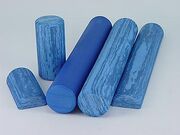- "SMR" redirects here. For other uses, see SMR (disambiguation).

self-myofascial release
Myofascial Release is a specialized massage technique in which the muscle tissue is stretched and manipulated to relieve tension in the fascia, the thin tissue covering the muscle fibers.[1] It works by breaking up fascial adhesions and also by manipulating certain neuromuscular receptors to allow muscles to release any tightness.[2]
Myofascial release can be self-administered, which is called self-myofascial release (SMR or SMFR), administered through the use of foam rollers. Myofascial release includes, but is not limited to, structural assessments and manual massage techniques which are designed for stretching the fascia and releasing bonds between fascia, integument, muscles, and bones. Myofascial releast techniques are applied with the goal of eliminating pain, increasing range of motion and balancing the body.[3] SMR techniques should be administered pre-workout to improve mobility and muscle function, or post-workout to relieve muscular tension without damaging muscle tissue. It can also be done at any other time one feels the desire to.[2]
Video Highlight[]
<videoflash>QJLxruO3su0</videoflash>
How to Do SMR Techniques[]

foam rollers are commonly used for SMR
Another reason SMR is so effective is the relative simplicity of the techniques. Below are the steps on how to self-administer myofascial release.
- Position the appropriate muscle on the foam roller and find any tight and/or tender areas.
- Once found, hold the muscle on the roller until the tenderness is decreased by 75%.
- Continue on to another tender spot.
- Do 1 – 2 sets per muscle group; it should take about 30 – 60 seconds for each muscle.
Key points to remember:
- Breathe deeply and slowly to help your body relax; rapid, shallow breathing will prevent your body from being able to release tension.
- Roll & move slowly; do not roll quickly over a muscle, as this will have the opposite effect of what you’re trying to achieve.
- Sometimes when you first begin SMR it may take a little longer for a muscle to release but keep at it and soon it shouldn’t take too long at all.
External Resources[]
- Self Myofascial Release Exercises
- Knee Knacker.com - a list of SMFR techniques
- Foam Rollers - a diverse selection of foam rollers
- Self-myofascial release resources - DVDs, books, etc.
References[]
- ↑ Mosby's Dictionary of Complementary and Alternative Medicine. (2005). Myofascial Release. Elsevier. Retrieved on 2008-10-03.
- ↑ 2.0 2.1 Ivanic, Curb (n.d.). Self Myofascial Release Technique. KneeKnacker.com. Retrieved on 2008-10-07.
- ↑ various (n.d.). Myofascial Release. Wikipedia. Retrieved on 2008-10-03.